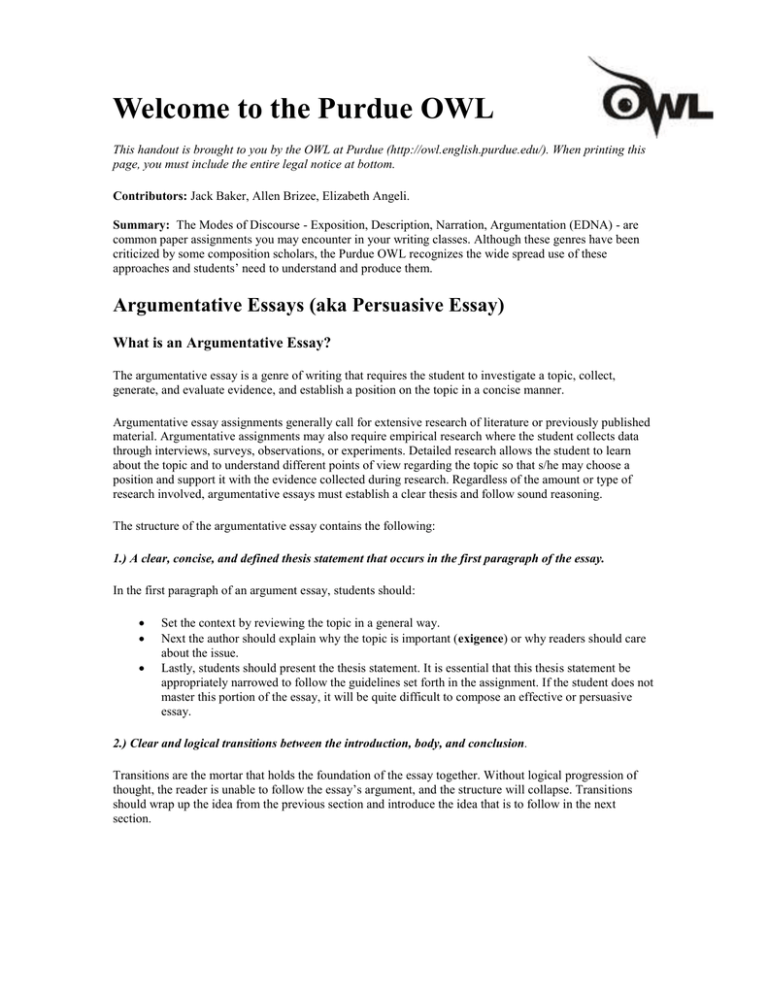
Welcome to the Purdue OWL
This handout is brought to you by the OWL at Purdue (http://owl.english.purdue.edu/). When printing this
page, you must include the entire legal notice at bottom.
Contributors: Jack Baker, Allen Brizee, Elizabeth Angeli.
Summary: The Modes of Discourse - Exposition, Description, Narration, Argumentation (EDNA) - are
common paper assignments you may encounter in your writing classes. Although these genres have been
criticized by some composition scholars, the Purdue OWL recognizes the wide spread use of these
approaches and students’ need to understand and produce them.
Argumentative Essays (aka Persuasive Essay)
What is an Argumentative Essay?
The argumentative essay is a genre of writing that requires the student to investigate a topic, collect,
generate, and evaluate evidence, and establish a position on the topic in a concise manner.
Argumentative essay assignments generally call for extensive research of literature or previously published
material. Argumentative assignments may also require empirical research where the student collects data
through interviews, surveys, observations, or experiments. Detailed research allows the student to learn
about the topic and to understand different points of view regarding the topic so that s/he may choose a
position and support it with the evidence collected during research. Regardless of the amount or type of
research involved, argumentative essays must establish a clear thesis and follow sound reasoning.
The structure of the argumentative essay contains the following:
1.) A clear, concise, and defined thesis statement that occurs in the first paragraph of the essay.
In the first paragraph of an argument essay, students should:
Set the context by reviewing the topic in a general way.
Next the author should explain why the topic is important (exigence) or why readers should care
about the issue.
Lastly, students should present the thesis statement. It is essential that this thesis statement be
appropriately narrowed to follow the guidelines set forth in the assignment. If the student does not
master this portion of the essay, it will be quite difficult to compose an effective or persuasive
essay.
2.) Clear and logical transitions between the introduction, body, and conclusion.
Transitions are the mortar that holds the foundation of the essay together. Without logical progression of
thought, the reader is unable to follow the essay’s argument, and the structure will collapse. Transitions
should wrap up the idea from the previous section and introduce the idea that is to follow in the next
section.
3.) Body paragraphs that include evidential support.
Each paragraph should be limited to the discussion of one general idea. This will allow for clarity and
direction throughout the essay. In addition, such conciseness creates an ease of readability for one’s
audience. It is important to note that each paragraph in the body of the essay must have some logical
connection to the thesis statement in the opening paragraph. Some paragraphs will directly support the
thesis statement with evidence collected during research. It is also important to explain how and why the
evidence supports the thesis (warrant).
However, argumentative essays should also consider and explain differing points of view regarding the
topic. Depending on the length of the assignment, students should dedicate one or two paragraphs of an
argumentative essay to discussing conflicting opinions on the topic. Rather than explaining how these
differing opinions are wrong outright, students should note how opinions that do not align with their thesis
might not be well informed or how they might be out of date.
4.) Evidential support (whether factual, logical, statistical, or anecdotal).
The argumentative essay requires well-researched, accurate, detailed, and current information to support
the thesis statement and consider other points of view. Some factual, logical, statistical, or anecdotal
evidence should support the thesis. However, students must consider multiple points of view when
collecting evidence. As noted in the paragraph above, a successful and well-rounded argumentative essay
will also discuss opinions not aligning with the thesis. It is unethical to exclude evidence that may not
support the thesis. It is not the student’s job to point out how other positions are wrong outright, but rather
to explain how other positions may not be well informed or up to date on the topic.
5.) A conclusion that does not simply restate the thesis, but readdresses it in light of the evidence
provided.
It is at this point of the essay that students may begin to struggle. This is the portion of the essay that will
leave the most immediate impression on the mind of the reader. Therefore, it must be effective and logical.
Do not introduce any new information into the conclusion; rather, synthesize the information presented in
the body of the essay. Restate why the topic is important, review the main points, and review your thesis.
You may also want to include a short discussion of more research that should be completed in light of your
work.
A Complete Argument
Perhaps it is helpful to think of an essay in terms of a conversation or debate with a classmate. If I were to
discuss the cause of World War II and its current effect on those who lived through the tumultuous time,
there would be a beginning, middle, and end to the conversation. In fact, if I were to end the argument in
the middle of my second point, questions would arise concerning the current effects on those who lived
through the conflict. Therefore, the argumentative essay must be complete, and logically so, leaving no
doubt as to its intent or argument.
Copyright ©1995-2013 by The Writing Lab & The OWL at Purdue and Purdue University. All rights
reserved. This material may not be published, reproduced, broadcast, rewritten, or redistributed without
permission. Use of this site constitutes acceptance of our terms and conditions of fair use.







